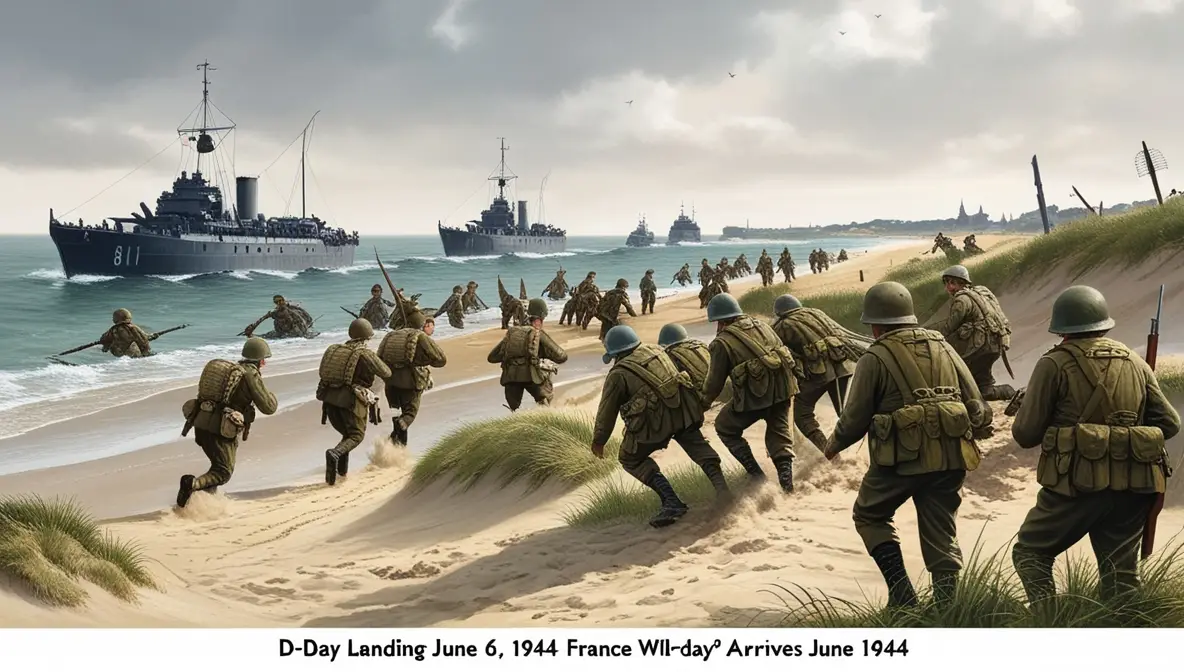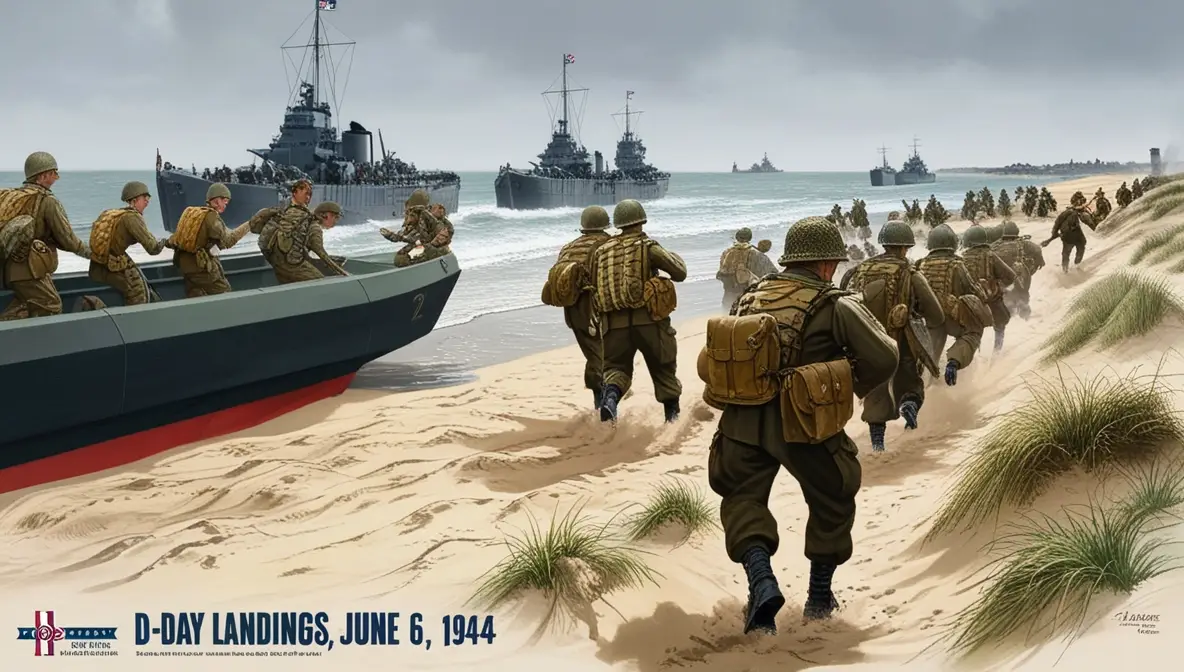D-Day Anniversary
D-Day: The Turning Point of World War II
D-Day, June 6, 1944, marks one of the most significant military operations in history: the Allied invasion of Normandy during World War II. This day, often referred to as “The Longest Day,” saw the largest amphibious assault ever undertaken, involving over 156,000 Allied troops, thousands of ships, and aircraft. The successful landings on the beaches of Normandy, France, played a crucial role in the eventual defeat of Nazi Germany and the liberation of Europe.

[su_box title=”D-Day Anniversary – Next years” box_color=”#fb0400″]
- Friday,June 06 2025
- Saturday, June 06 2026
- Sunday,June 06 2027
- Tuesday, June 06 2028
[/su_box]
What Was D-Day?
D-Day refers to the Allied invasion of Normandy, a carefully planned and highly coordinated effort involving forces from the United States, the United Kingdom, Canada, and other Allied nations. It was the culmination of years of planning by the Allies to open up a Western Front against Germany, relieving pressure on Soviet forces fighting on the Eastern Front.
The operation, codenamed Operation Overlord, involved crossing the English Channel and landing on five separate beaches—Utah, Omaha, Gold, Juno, and Sword—along the Normandy coast of France. The primary objective was to establish a foothold in Nazi-occupied France, from which the Allies could advance and ultimately push the Germans back.
The Planning of D-Day
The planning for D-Day began long before June 6, 1944. The Allies knew they needed a second front to relieve the Soviet forces and to increase the chances of defeating Nazi Germany. The planning process involved detailed intelligence gathering, deception tactics to confuse the Germans, and meticulous coordination between multiple Allied nations.

The invasion was originally scheduled for June 5, but poor weather conditions forced Supreme Commander General Dwight D. Eisenhower to delay it by 24 hours. This decision was critical, as even slight changes in weather or timing could have drastically altered the outcome of the invasion.
Operation Overlord was not just a military operation but also a logistical marvel. The Allies built artificial harbors (known as Mulberry Harbors) and developed portable bridges to support the invasion and subsequent operations. They also laid down miles of underwater pipelines (Operation Pluto) to provide fuel to the advancing armies.
The Five Beaches of Normandy
The Allied forces divided the Normandy coast into five beaches, each assigned to different national forces:
- Utah Beach – American forces landed here and faced lighter resistance compared to other beaches. Despite initial confusion, the troops quickly secured their objectives.
- Omaha Beach – One of the most heavily defended sectors, Omaha Beach saw the bloodiest fighting on D-Day. American troops faced intense machine-gun fire and suffered significant casualties.
- Gold Beach – British forces landed here and encountered moderate resistance. They successfully linked up with troops from the other beaches later in the day.
- Juno Beach – Canadian forces landed at Juno Beach and faced heavy fire. However, they made significant progress and eventually pushed inland.
- Sword Beach – British forces, along with French commandos, landed on Sword Beach. They encountered resistance but managed to secure the beach and advance towards the city of Caen.
The Role of Airborne Troops
In addition to the amphibious landings, thousands of paratroopers were dropped behind enemy lines to disrupt German defenses and secure key positions. These airborne divisions played a crucial role in the success of D-Day by capturing bridges, roads, and other critical infrastructure that would support the advancing Allied forces.
Two of the most famous airborne divisions involved in the D-Day invasion were the U.S. 82nd and 101st Airborne Divisions. These soldiers faced heavy resistance upon landing but were able to complete their objectives, contributing significantly to the overall success of the invasion.
The Aftermath of D-Day
The initial success of the D-Day invasion was only the beginning. The battle for Normandy would last several weeks, with fierce fighting as the Allies pushed inland. The Germans, under Field Marshal Erwin Rommel, mounted a strong defense, but they were unable to stop the Allied advance.
The capture of the port city of Cherbourg and the breakout from the Normandy beachhead were critical milestones. By August 1944, Paris was liberated, and the German forces were in full retreat. D-Day marked the beginning of the end for Nazi Germany, as the Allies continued their push towards Berlin.
Why D-Day Was Important
D-Day was a turning point in World War II for several reasons:
- Strategic Victory: The invasion opened up a second front against Nazi Germany, which was crucial in dividing the German forces and hastening the end of the war.
- Relief for the Soviets: The invasion alleviated pressure on the Soviet forces fighting on the Eastern Front, allowing them to advance westward and contribute to the defeat of Germany.
- The Beginning of Liberation: D-Day was the start of the liberation of Western Europe from Nazi occupation. By the end of 1944, most of France, Belgium, and the Netherlands were free from German control.
- Demonstration of Allied Cooperation: The operation was a testament to the collaboration between the United States, United Kingdom, Canada, and other Allied nations. It showcased the strength of their combined military might.
The Heroes of D-Day
Many soldiers and officers who took part in the D-Day invasion became legendary for their bravery and leadership. Some notable figures include:
- General Dwight D. Eisenhower: The Supreme Commander of Allied forces in Europe, Eisenhower made the crucial decision to go ahead with the invasion despite uncertain weather conditions.
- Major John Howard: Led the famous capture of Pegasus Bridge, a key objective on D-Day that prevented German counterattacks.
- Ranger Lieutenant Colonel James Rudder: Led the assault on Pointe du Hoc, where American Rangers scaled cliffs under heavy fire to destroy German artillery.
Thousands of soldiers displayed acts of extraordinary courage on D-Day, many of whom were awarded medals for their bravery.
Legacy of D-Day
D-Day is remembered not only for its military significance but also for the sacrifice of the thousands of men who fought and died on the beaches of Normandy. Each year, memorials and ceremonies are held to honor the soldiers who participated in the invasion, and the Normandy beaches have become a place of pilgrimage for people wishing to pay their respects.
The Normandy American Cemetery, overlooking Omaha Beach, is one of the most visited sites, where thousands of white crosses mark the graves of soldiers who gave their lives for the liberation of Europe.
D-Day, June 6, 1944, stands as a monumental day in world history, symbolizing the determination, courage, and sacrifice of the Allied forces. The success of the Normandy invasion paved the way for the eventual defeat of Nazi Germany and the liberation of Europe from tyranny. The legacy of D-Day continues to inspire generations, reminding us of the cost of freedom and the bravery of those who fought to secure it.


